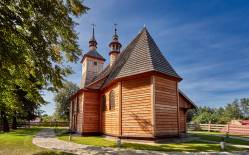The tserkva of the Dormition of the Blessed Virgin Mary was built in 1761, at a location of an older wooden church from 1688. In the period of the widespread Latinisation, some tserkvas in our region acquired features typical for Roman Catholic churches, and even services were held there in Latin. Accordingly, it is said that in 1786 the tserkva was transformed into a parish church of the Assumption of the Blessed Virgin Mary, and later in 1863–1875 Greek Orthodox liturgical rite was reinstated here.
The church has been preserved in an unchanged form, its structure retaining all the layers of architectural features. The original wall paintings were restored in 1958–1960, and then renovation works were again carried out here during 1988–2000.
Inside we can see the original 18th century Baroque interior design and furnishings. There are also a few epitaphs from the 1800s. Originally there was also a benevolent icon of the Holy Mother from 1490, but it was stolen in 1992. Its copy was placed here in 1995.
As old as the church, the chapel standing nearby is ornamented inside with wall paintings which depict miraculous events connected with the cult of the icon of the Holy Mother. The chapel was expanded in the mid-1800s.
A legend says that a Greek merchant Nicholas Korniaktos, on his way to the trade fair in Jarosław, was chasing his horses and came to a forest clearing. There, he saw the animals kneeling before an icon of the Holy Mother, affixed to a pear tree. Inspired by this apparition, he made a vow that he would build here a chapel in honour of Virgin Mary. And he did that.
In the vicinity we can see a field altar built in the 1980s, as well as the old and the new rectory, farm buildings and home of the Convent of Servants of the Blessed Virgin Mary. In Chłopice there is also a manor house from the 1930s, with a park.
Artefacts related to Corded Wire Culture, found within the village, date from the times of the Stone Age. Urnfield burial grounds were also unearthed here.
Photo: Krystian Kłysewicz
Gallery

Recommended venues on the Trail



This website has been modernized with the financial support of the European Union under the Cross-Border Cooperation Programme Poland-Belarus-Ukraine 2014-2020. The responsibility for its content lies solely with the Podkarpackie Regional Tourism Board and cannot, in any case, be treated as a reflection of the position of the European Union, the Managing Authority, or the Joint Technical Secretariat of the Cross-Border Cooperation Programme Poland-Belarus-Ukraine 2014-2020.













